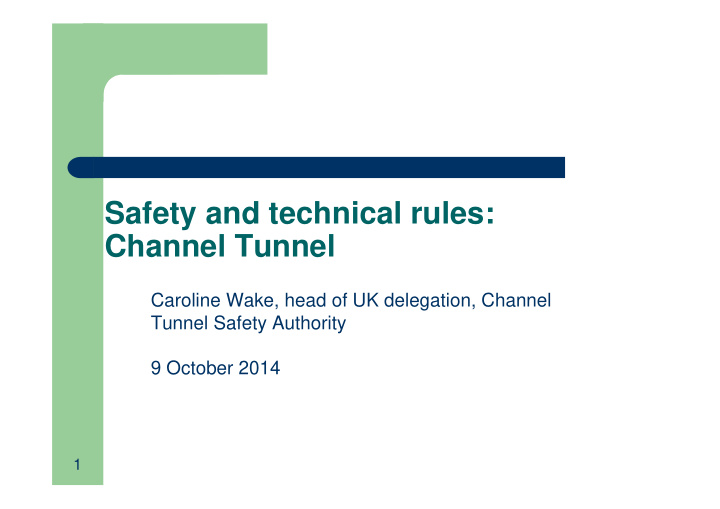



Safety and technical rules: Channel Tunnel Caroline Wake, head of UK delegation, Channel Tunnel Safety Authority 9 October 2014 1
History 1986: Treaty and Concession Agreement – Eurotunnel develops technical designs and operating rules for IGC approval 1994: Technical and safety rules established – risk prevention shared between rolling stock and infrastructure 2000 onwards: Evolution of TSIs, emphasis towards standardisation of rolling stock 2007: Market opening – IGC opens consultation on rules 2011: ERA technical opinion – recommends further changes 2
Challenges Lots of special rules = barrier to new entrants? Outdated rules (e.g. splittability) Unclear rules (e.g. “smoke tightness”) Questionable basis for some rules (e.g. train length) Alleged lack of justification for others (e.g. running capability for passenger trains) Governance and availability of rules (reliance on IM to develop and make available) 3
Principles: what does “clean” look like? No duplication/repetition of TSI or CSM requirements Justification of necessary specific requirements Removal of specifics that cannot be justified Coherence with EU framework (i.e. included as specific cases or notified as national rules; separation of “safety” and “technical”) Clear structure: use of “reference document” parameters, ERA rule management tool 4
Methods and approach - lessons Collaboration with the infrastructure manager (or whoever “owns” the rules): Eurotunnel very supportive and have put resources into clean-up work Consultation with RUs/manufacturers: to challenge our thinking Open and constructive exchanges with ERA: dialogue is more productive than room documents and technical opinions! Proper evidence: to support decisions to keep/remove 5
Key outcomes (to date) No specific requirements for freight (no extra running capability; no requirement to rescue other trains) Virtually all passenger train specifics eliminated (splittability, smoke tightness, continuous corridor) Remaining requirements more clearly justified (specific case for running capability for passenger trains) more clearly explained (linked to TSI parameters) more available (published on website and ERA databases) 6
Next steps Technical rules for vehicles: completed – revised rules published by IGC July 2013; on RDD December 2013 Safety (operating) rules: currently consulting on revised (shortened) notification, closes 30 October Technical rules for fixed subsystems: to be done in 2014/5 (we anticipate few specific rules) Ongoing development and management of rules: new collaborative approach led by IM 7
Recommend
More recommend